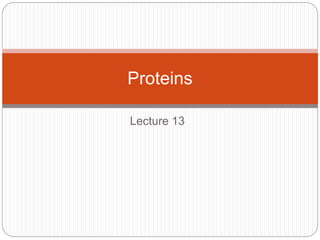
Proteins lecture 13
- 2. Classification of proteins A. Functional classification of proteins B. Classification based on chemical nature and solubility C. Nutritional classification of proteins
- 3. A. Functional classification of proteins 1. Structural proteins: keratin of hair and nails, collagen of bones 2. Enzyme or catalytic protein: hexokinase, pepsin 3. Transport protein: hemoglobin, serum albumin 4. Hormonal proteins: insulin, growth hormone 5. Contractile proteins: Actin, myosin 6. Storage protein: ovalbumin, glutelin 7. Genetic proteins: nucleoproteins 8. Defense proteins: snake venom, immunoglobulins 9. Receptor proteins: for hormones, viruses
- 4. B. Classification based on chemical nature and solubility
- 5. Simple proteins (a) Globular proteins: These are spherical or oval in shape, soluble in water or other solvents and digestible i. Albumins: soluble in water and dilute salt solutions, coagulated by heat. e.g. serum albumin, ovalbumin, lactalbumin ii. Globulins: soluble in neutral and dilute salt solutions. e.g. serum globulins, vitelline iii. Glutelins: soluble in dilute acids and alkalies and mostly found in plants. e,.g. glutelin, oryzenin
- 6. iv. Prolamine: soluble in 70% alcohol. e.g. gliadin, zein v. Histones: strongly basic proteins, soluble in water and dilute acids but insoluble in dilute ammonium hydroxide. e.g. thymus histones vi. Globins: These are generally considered along with histones. However globins are not basic proteins and are not precipitated by ammonium hydroxide vii. Protamines: They are strongly basic and resemble histones but smaller in size and soluble in ammonium hydroxide. They are also found in association with nucleic acids. e.g sperm proteins
- 7. viii. Lecitins: They are carbohydrate binding proteins and are involved in the interaction between cells and proteins they help to maintain tissue and organ structures. In lab, they are useful for the purification of carbohydrates by affinity chromatography. e.g agglutinin
- 8. (b) Fibrous proteins: these are fiber like in shape, insoluble in water and resistant to digestion. scleroproteins are predominant group of fibrous proteins i. Collagen: are connective tissue proteins lacking tryptophan. ii. Elastin: found in the elastic tissues such as tendon and arteries iii. Keratins: present in the exoskeletal structures e.g. hair, nails, horns
- 9. 2. Conjugated proteins i. Nucleoproteins: Nucleic acid (DNA or RNA) is the prosthetic group. e.g Nucleohistones, nucleoprotamines ii. Glycoproteins: The prosthetic group is carbohydrate. The term mucoprotein is used if the carbohydrate content is more than 4%. e.g mucin, ovomucoid iii. Lipoproteins: proteins found in combination with lipids as the prosthetic group. e.g. serum lipoproteins iv. Phosphoproteins: Phosphoric acid is the prosthetic group. e.g casein, viltelline
- 10. v. Chromoproteins: The prosthetic group is colored in nature e.g hemoglobin, cytochromes vi. Metalloproteins: These proteins contain metal ion such as Fe, Co, Zn, Cu, Mg etc e.g. carbonic anhydrous
- 11. 3. Derived proteins They are of two types: The primary derived are the denatured or coagulated or first hydrolyzed products of proteins. The secondary derived are the degraded (due to break down of peptide bonds) product of proteins
- 12. (a) Primary derived proteins: i. Coagulated proteins: These are the denatured proteins produced by agents such as heat, acids, alkalies etc e.g. cooked proteins, coagulated albumin ii. Proteans; These are the earliest products of proteins hydolysis by enzymes, dilute acids, alkalies etc which are insoluble in water e.g. fibrin formed from fibrinogen iii. Metaproteins: These are the second stage products of protein hydrolysis obtained by treatment with slightly stronger acids and alkalies e.g. acid and alkali metaproteins
- 13. (b) Secondary derived proteins: These are the progressive hydrolytic products of protein hydrolysis. These include proteoses, peptones, polypeptides and peptides.
- 14. C. Nutritional classification of proteins 1. Complete proteins: These proteins have all 10 essential amino acids in the required proportion by the human body to promote good growth e.g. egg albumin, milk casein 2. Partially incomplete proteins: These proteins partially lack one or more essential amino acids and can promote moderate growth e.g. wheat and rice proteins 3. Incomplete proteins: These proteins completely lack one or more essential amino acids. hence they do not promote growth at all e.g. gelatin (lack Trp), zein (lack Trp, Lys)